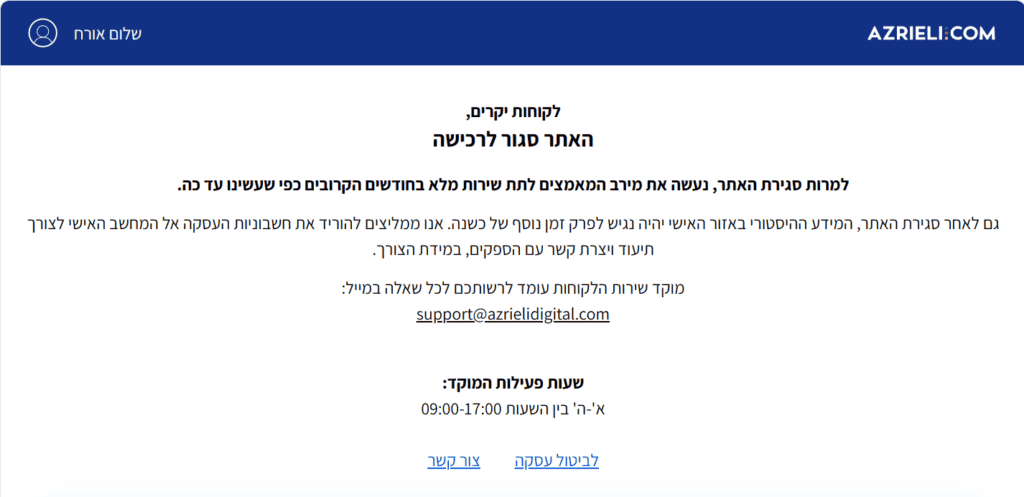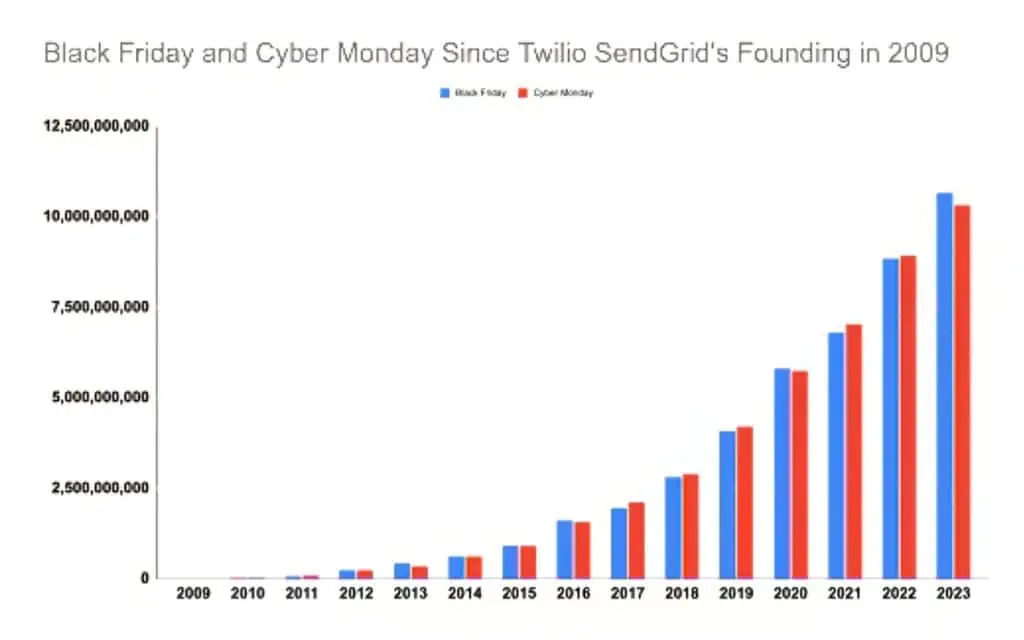The year 2023 has been an excellent year for email, and all signs show that its influence is increasing annually * Some email trends and significant changes expected in 2024 will further enhance the potency and status of email * Marketers will need to specialize in order to succeed in email marketing.
תוכן עניינים
Grandfather in a young body
Email marketing is considered the digital marketing pioneer and is proclaimed every year.
The year 2023 has been outstanding for email, and its impact continues to grow. Significant changes in 2024 will strengthen the importance of email.
Email marketing is critical as an asynchronous, non-intrusive communication channel (unlike push messages, WhatsApp, or marketing SMS). Email is a channel that enables personalization and is cost-effective and reliable.
SendGrid, the largest email provider, annually shares a graph showing the volume of emails sent during Black Friday and Cyber Monday. A recent report shows a 21.69% increase in Black Friday emails and a 15.72% increase in Cyber Monday emails this year.
Email seems here to stay, as its influence and importance are steadily rising.
Closure of large Israeli marketplace sites
In December 2023, Azrieli Group announced the closure of its marketplace Azrieli.com. A few days later, Melisron announced the closure of its sites Baligam and Grou, and later Shufersal also announced that it would focus on online food only and close its non-food activity online.
These groups invested a great deal of capital in acquiring ventures, improving them technologically, and trying to become leading players in the field. Azrieli noted in a statement sent to TASE that: “… The e-commerce market in Israel is not yet sufficiently developed, with a low penetration rate alongside a significant presence of global sites.”
She also notes that international sites are prioritized over local sites. It may be referring to an exemption from VAT given to private consumers on orders from abroad up to $75. An exemption that is currently (unfortunately) being talked about eliminating during 2024.
For some unknown reason, Azrieli chose to blame external factors for her lack of success. This primarily demonstrates the Israeli marketplaces’ inability to distinguish themselves from global rivals. These are traditional retail businesses (brick and mortar) that have tried to translate their offline success into online as well. They built inflated operations bloated with human resources and expenses, based on low fees and lost money. Most of all, they missed an understanding of the needs of the Israeli customer, who today can choose, the ability to compare prices and attractive and efficient international alternatives. There are successful Israeli examples of marketplaces and trade arenas such as Super-Pharm, KSP and several others.
The timing of marketplaces closing near the end of the year is not a coincidence, and it is a common practice for publicly traded companies to do so.
See more at the end of the article “Read more”.

Consequences of the war
These lines were written during the intense “iron sword” conflict in Israel. Many individuals participate in military reserves (including myself, as I completed two rounds of military reserve duty), tens of thousands volunteer for civilian projects, approximately 120,000 people are displaced from their homes in the northern and southern regions (with businesses in the north experiencing greater economic impacts than those in the south), which includes both businesses and their owners. As with COVID-19, physical distancing has led to the growth of online stores and e-commerce sites like mushrooms after the rain. Most of them use email marketing to operate the stores, send operational and transactional emails during the ordering process and customer retention processes, along with sending newsletters and marketing campaigns.
Creating an online store or e-commerce website is now relatively easy, unlike in the past, and is no longer reserved only for deep-pocketed businesses.
The war has fostered patriotism among Israeli consumers, leading to a strong desire to enlist. This mobilization is expressed through a preference for Israeli products – “Buy Blue and White” has transformed from a somewhat hollow slogan to the prevailing sentiment. Israeli-produced agricultural goods, even if they are more expensive, are now favored by Israeli consumers, and a law has been enacted to label Israeli agricultural products (hopefully, this will continue after the war).
At the same time, some Israeli consumers called for a boycott of the popular website Shein, which was a favorite of the audience until then, after it was reported that they sold the Palestinian flag on the site and even used the packages to be wrapped in the colors of the Palestinian flag. This move and the elimination of free shipping led to a 61% drop in website sales.
The preference for Israeli products and support for Israeli businesses in the wake of the war raises even higher eyebrows regarding the timing of the closure of the large retailers’ marketplaces.
See more in the article Email enlisting to fight in war and How to set up an online store
Deliverability challenges – Email providers set stricter standards:
Starting February 1, 2024, email providers Gmail and Yahoo will begin enforcing domain authentication for bulk senders that will must have SPF and DKIM domain verification and require marketeers to publish a DMARC record.
At the same time, marketeers are required to meet a very low threshold of user reports of spam and allow recipients to unsubscribe easily by clicking on the “unsubscribe” easy unsubscription link.

The new Gmail and Yahoo requirements (that got the funny name” Yahoogle”) will apply to anyone who sends more than 5,000 emails per day to Gmail addresses, while Yahoo does not have a threshold setting for bulk sender.
The new requirements are relevant to many senders because if a business passes a threshold of 5,000 emails to @gmail.com domain on a specific day from all infrastructures (and not just from the email marketing platform) it will automatically be considered a bulk sender, and the new requirements apply to it.
Gmail and Yahoo requirements:
- Send emails from an authenticated domain using SPF or DKIM (it is the responsibility of the sender to set up SPF and DKIM records in the domain’s DNS).
- It will no longer be possible to email using an email platform from a personal free email address such as @gmail.com or @yahoo.com (it is the responsibility of the sender to have and use a registered business domain for bulk email sending).
- Enable Easy Unsubscription by clicking on “Unsubscribe” which appears next to the sender’s email address (it is the responsibility of the mailing system to add the appropriate code to the header).
Send desired emails while maintaining a very low threshold for spam reports, between 0.1% and 0.3% spam reports by users.
Reports of spam from Gmail cannot be seen in the mailing system, only in Postmaster Tools (it is the responsibility of the mailer to add code to DNS and start monitoring the data in Google Postmaster ).
- Publish DMARC Policy is also p=none (it is the responsibility of the mailer to add an appropriate record to the DNS, preferably with an appropriate tool).
See more in the article on the new requirements for Gmail.
Trust = BIMI and Gmail Blue
The email channel has evolved to be a safe and trusted channel among customers. Thanks in part to protocols for verifying the sending domain. The importance of creating the same trust will continue to be important and brands will want to stand out from other brands and earn points in the competition for customers’ attention.
The BIMI protocol allows brands to display their logos in recipients’ inboxes, and last year Google started displaying a blue check next to the logo ( BIMI ) that verifies that the domain and logo belong to a verified brand. Verification does not depend on Google, but rather relies on the four protocols that are interrelated.
SPFand DKIMare the protocols for domain authentication, DMARC rides over them and gives them meaning per sender (Authenticated / Aligned), BIMIriding on the last three provided that the mailer in DMARCPolicy is in enforcement mode.
In email providers such as Gmail, the logo can only be displayed for brands that have undergone VMC verification (requires a registered trademark on the logo in one of the countries recognized by the VMC (registration of a trademark outside of Israel) and payment for the certificate (approximately $1,500 per year).

As a first step, brands are required to authenticate the sending domain using SPF and DKIM protocols across all their email platforms. The average business has several ESPs for various mailing activities: business (such as from Google Workspace), transactional (such as registration confirmations, password reset, order confirmations, etc.), operational (such as invoices, reports), marketing (campaigns and newsletters).
Domain authentication or sub-domain authentication must be done in all ESPS and email platforms and the correct way to do this is by implementing a DMARC record using a tool and going through the DMARC journey up until enforcement mode.
At this stage, you can embed a BIMI logo in a suitable format, including setting up the DNS record of the domain and hosting the logo image in an appropriate format on a hosting server.
The final step is to register a trademark on the business logo in a country recognized by the VMC registrar and obtain VMC certification from one of two bureaus authorized to verify logo ownership and domain affiliation.
It’s a long process and it’s not cheap, but at the end of the process there is a big advantage for email senders.
See the article for more on DNS and Digital Asset Protection
See more on email stream separation
Generative AI – The Good, the Bad and the Terrible
The term generative AI burst into our lives in November 2022 with the launch of ChatGPT and completely changed so many things. The human brain struggles to apply the power and speed with which it enters so many areas while developing with the blink of an eyelid from a lame duck to a perfect swan. His entry into our lives includes quite a few concerns on the part of so many. From content creators, writers, illustrators, painters, designers, photographers and other artists to professionals who were considered more stable until now who fear for their professional and economic future because of artificial intelligence that will do their job better, faster and cheaper.
Various predictions predict that many professionals are in danger of losing their jobs to artificial intelligence, others reassure that artificial intelligence is like the Word that replaced the typewriter for the writer and Photoshop that replaced the light table for the designer. But many areas are in the crosshairs as AI threatens to do their jobs better, more efficiently and cheaply. Professions such as law, radiologists who interpret X-rays, CT and MRI, customer service representatives, programmers, data analysts, journalists, financial professions such as analysts and traders and more.
The implications of “creative AI” on the labor market will continue to occupy us all in the coming years and will have far-reaching effects not only on the labor market.
Thanks to creative AI, email marketing will be more accurate and personal. It will be possible to teach AI the brand language and how to act in the various scenarios by studying all the emails sent to customers in the past and learning all the accumulated organizational knowledge (Knowledge Base), in order to create marketing campaigns, or marketing and service customer journeys, quickly and efficiently handle customer service issues and in a very personal way adapt to user preferences, style and content that will be personalized in a way that was not possible until now.
On the dark side of AI, language models will be much more precise and require little data to be able to create text, sound, video, and image representations that can easily trick the human brain. The creative AI will create highly personal spam and phishing messages in free language. This will increase the motivation of professional spammers and challenge spam filters.
It was recently revealed that Arena Group, owner of Sports Illustrated magazine, fired the CEO after it was revealed that they published AI-generated articles signed by fictitious creators whose names and profile picture were also created by artificial intelligence.
When it comes to email marketing, when recipients’ inboxes are flooded with messages, some of which will be fictitious or phishing and scamming messages, it emphasizes the importance of brands looking legitimate by, among other things, verifying email marketeers, adding BIMI – verified logos, and brands will also be able to display the blue check in Gmail.
See the article for more on the blue check in Gmail
See article for more information on cyber risks for email marketing
See more articles on AI and the bright future of marketing email AI and its dangers
Around the world Privacy laws
Another trend that cannot be ignored is privacy laws in a program similar to that of the European GDPR and the California CCPA, which will be enacted and enacted in other US states to replace the outdated Can Spam Act. Similar privacy laws have been introduced in other countries such as Brazil and even China.
Israel pioneered the enactment of the Privacy Law back in 1981 and made another breakthrough with the amendment to the Flash Law in 2008, which received the nickname “Spam Law.” However, with the exception of occasional amendments, the Israeli Privacy Protection Law is not suitable for so many technological changes that have occurred in the more than forty years since the law was enacted. This prevents Israeli entities from complying with the strict European standards, and the more states in the US make a change in their privacy laws, the more Israel will be required to address it.
Disruption of engagement data, Apple’s privacy change, IOS17, IOS 15, and what’s next?
In parallel with state privacy regulations, we are witnessing moves by technology giants, led by Apple, which brands itself as the knight of privacy. Privacy, it turns out, is USP (Unique Selling Point), which is reflected in the design of its products, the way it processes the data (processing information as much as possible on the device and not in the cloud), and privacy features that reduce the ability to track users without their will. When it comes to impacting the world of email marketing, Apple’s Privacy Protection (MPP) change announced under IOS15 has disrupted email opening data and other privacy features.
At IOS17 there has been a change, there is a change in the way links are displayed, which hurts the big advertisers, especially social networks and Google. The bottom line is that there doesn’t seem to be any intention at the moment to compromise or disrupt click-through data on emails.
See the article on Apple’s privacy change, whether the privacy change is relevant in Israel , and an article on the changes under IOS17
Close inactive Gmail accounts
Google has announced that starting in December 2023, it will delete inactive Google accounts. She said she would delete individual Gmail accounts, not business (Workspace) accounts. Before deleting accounts, it will send notifications to both account holders and accounts linked to those accounts (such as accounts configured as backup password recovery) and will do so “very carefully and slowly.”
The deletion will be not only of the Gmail account but of all products associated with the account such as Google drive, Docs, Sheets and more.
To keep an account in active status, the user must do one or more of the following simple actions under the specific user: read or send an email via Gmail, use Google Drive, watch a YouTube video, download an app from the Play Store, perform a Google search under the account, sign in or log in with Google to a third-party account.
Sending emails to a deleted account will result in hard bounce.
Usually, the mailing systems will block addresses that have switched to hard bounce status, but it is better to perform a periodic health check for email addresses using the email validation service.
Another danger that may occur following account closures is an increase in reports of spam by users. As I mentioned earlier, starting February 1, 2024, Google is setting strict requirements for spam reports from users – up to 0.3%.
The email addresses of accounts deleted by Google will be available for re-registration by anyone and not necessarily the original owner of the account, about 30 days after deletion.
Accounts that reactivate after those 20 days pose marketeers:
- Deleted accounts operated by new users are actually people who have not given consent to your emails, who will start receiving emails from you, which may lead to an increase in spam reports.
- Some of these addresses will be transformed by Gmail into recycled spam traps.
- In a country like Israel, where the “Spam Law” applies, this may increase the risk of spam lawsuits.
It’s a good idea to monitor hard bounces using an email validation service. Be especially wary of addresses that show invalid and become active after a month. An account deleted and activated by another person will lose access to all services connected to the account. This can create a situation where the new account owner will have access to accounts and services connected to the email address. Even if the new user of the account does not know the password to the account, they will be able to recover a password and gain access to the accounts.
See more in the article on email validation services and an article on the causes of bounces
Discontinuation of third-party cookies in Chrome browser
Google has announced that it will stop supporting third-party cookies on the Chrome browser. The move has already been postponed twice and should happen (if not postponed again) at the end of 2024.
Not all cookies are the same: a 1st party cookie is a piece of code (cookie) that the browser “plants” on a surfer’s computer in order to identify the surfer and his preferences on the site itself. For example, sites “remember” the session so as not to ask us for a password every time (there are sites where for security reasons the session is very short in order to ask for a password for frequent spells), adjust content according to the behavior of surfers on a specific site, etc.
On the other hand, a 3rd party cookie is a cookie used to target surfers on the “web” and a huge advertising industry relies on it. This is a significant move that has far-reaching implications for the industry.
Some claim, seriously or jokingly, that Google is promoting the move out of concern for users’ privacy. On the other hand, some argue that the move stems from regulatory considerations as dictated by modern privacy laws such as the GDPR in Europe, the CCPA in California and other privacy laws in other territories. Others argue that this is because Google exploits privacy regulations to its advantage, and under the guise of concern for users’ privacy, it actually strengthens its already monopolistic power in the online advertising market. Google says it will offer a solution that it claims makes third-party-data redundant but will require the entire market to align itself to the standard it offers and will require a huge ecosystem of Mart-tech systems to adapt to Google’s flute, which will further enrich it and cement its position as the web’s dominator. Competing platforms are looking to create a coalition that will enable data sharing at a uniform and extensive standard as a substitute for third-party cookies that do not pass through Google.
Stopping the use of third-party cookies will strengthen the use of existing data in the organization (1st parti data) and increase the use of email marketing.
See more in the article on third-party cookies
AMP Interactive Emails
The standards by which email works do not change frequently. We can open the Chrome browser to watch interactive content, fill out forms, and more, but when we open our Gmail on the same Chrome, the experience is like opening a static document. While you can display GIFs that feel animated, not much else. Google developed AMP technology, short for AMPHTML (Accelerated Mobile Pages). New technology designed to create a great user experience on websites that load instantly, will enable the creation of especially rich stories and interactive advertisements and also brings good news to the world of email:
On its basis, AMP For Email was developed – a technology that makes it possible to create interactive content by email, similar to the newspaper paper that comes to life and becomes alive in the “Harry Potter” films. Imagine that an email you sent to a customer becomes interactive in a way that has not been possible until now.
In Israel and the United States, this technology is not known at all, but in India and other territories it is flourishing. The developer of the technology is the Indian giant Netcore Cloud, which promotes the concept of inbox commerce – an interactive email inbox through which customers can search, order and track all their online purchases.
Email using AMP technology behaves like a combination between an app and a website and eliminates the need to click to go to a website or landing page (reducing friction and fewer actions on the part of the customer) in order to complete the action and creates endless possibilities for creating “apps” within the email.
AMP For Email creates a rich and dynamic inbox experience compared to static emails. The body of the email becomes a web page (almost). With the help of technology, you can display a carousel of images, create paragraph tabs like on a website, display in the email itself the current inventory at that moment and even order products directly from the body of the email itself. This means, for example, that you can update prices and availability of inventory and products according to demand, while the campaign is “live” and even after the campaign is sent. The recipient can perform actions directly from the email, such as choosing dates for the performance, filling out forms and more.
There has been talk about AMP For Email technology for several years now, and every year we promise that it will break into our lives and change everything we knew about email. In the US, there is almost no demand for the technology, and it is likely that until Apple adopts the technology, it will remain widespread only in territories such as India, where Gmail, which supports the technology, is also the dominant email inbox.
See more in the article on AMP For Email
האזנה לפודקאסט

פודקאסט ובלוג העוסקים בנושאי אימייל מרקטינג (email marketing), עבירות אימיילים (deliverability) ושיווק.
הגעתם אל הבלוג והפודקאסט המובילים והמעודכנים ביותר בעברית בנושא אימייל מרקטינג ועבירוּת אימיילים הכולל עשרות רבות של מאמרים מפורטים ופודקאסטים בנושא אימייל מרקטינג למתחילים ומתקדמים ומכסה את התחום בצורה מקצועית.
חלק מהפרקים הם ראיונות עם מומחי אימייל מרקטינג בינלאומיים מובילים.
אימייל מרקטינג הוא ערוץ ותיק, אבל אולי דווקא בגלל שהוא “הסבא” של המדיה הדיגיטלית הוא לא מקבל את תשומת הלב וההתמקצעות הראויה.
אבל זה הולך ונהיה קשה… כדי להצליח באימייל מרקטינג צריך להתמקצע ולא לסמוך רק על כך שהפלטפורמה (מערכת הדיוור) תעשה את הכל.
אפשר למצוא כאן עשרות מאמרים ופודקאסטים מקצועיים ומפורטים בנושא אימייל מרקטינג, עבירוּת אימיילים, סקירת מערכות דיוור, אוטומציה שיווקית, שיווק באמצעות תוכן, אימייל מרקטינג עבור איקומרס, טיפים לשיווק במייל ועוד.
A blog and a podcast (in Hebrew) about email marketing, email deliverability, marketing, and data.

Viral email
The multiplicity of channels and the cruel algorithm of social networks have led to the search for new and creative ways in which content creators and marketers can be exposed to new audiences on the same platform, with the understanding that those who consume content on a particular channel will be more attentive to being exposed to new content on that channel. Here’s how to look for viewers for a YouTube channel on other YouTube channels, podcast listeners should be found through exposure to other podcasts, and finding new recipients for newsletters should be found through exposure to readers of other newsletters.

Mutual advertising in newsletters (sometimes paid and sometimes as a kind of barter) is nothing new, but the simplicity with which email can now go viral is interesting and has been found to be very effective. Two simple yet innovative ideas turn email marketing into a viral channel that allows newsletter recipients to participate in a kind of referral program, a rewards program that rewards them for sharing the newsletter with colleagues and acquaintances.
The value of the benefit received by a recipient who participates in the program increases the more people he joins. Top newsletters such as Morning Brew do this very successfully, but anyone with a newsletter can do so with services such as SparkLoop, Viral-Loops or Beehiiv.
The innovation implemented in some of these services is turning email into a discovery channel through which recipients can discover new newsletters and subscribe to them at the click of a button.
Many content creators use the ConverKit system that bought Sparkloop and the Beehiiv email and automation platform also implements a newsletter referral program.
AI-powered SEO
I mentioned earlier the generative AI revolution. The search market is currently undergoing tectonic changes as from searching by keywords on Google there is a trend of searching using ChatGPT and the like. This will cause shocks in search, SEO (organic website promotion), and requires brands to create content that will leverage the answers that ChatGPT and the other tools will return as an answer to the search question to include one brand or another in the answers.
Omni Channel
The multichannel trend has been going on for several years and will intensify further in the coming years. Omnichannel makes us as humans very confused when we look for something sent to us. “How did you send it to me? is a common question. Email is considered an easy channel to find your hands and feet. Search and filtering options, archiving old messages and more features make it the safest and most convenient for retrieving messages years back.
The attribute of email as an asynchronous channel also makes it the channel considered by consumers to be the least intrusive and burdensome.
“Consumers are willing to share their email addresses with brands,” says Chad S. White, head of research at Oracle Digital Experience Agency and author of Email Marketing Rules. “This is because consumers overwhelmingly prefer to receive commercial communications via email rather than through other channels. On the other hand, consumers are much less eager to receive branded communication through other channels such as SMS or push channels such as WhatsApp. As a result, consumers are very hesitant to share their email address and phone number because they know it could expose them to further marketing communications through less favored channels.”
As marketers, we don’t want to make ourselves miserable for customers. Therefore, choosing the right channel, at the right time, to send the right message, in the right dose, often depends on the strength of the signals we receive from customers and the analysis of their behavior.
האזנה לפודקאסט
Returning to the Roots and a Blue Ocean Marketing Opportunity
I mentioned the challenges associated with our dispersed attention and that of our customers due to the multiplicity of channels. Each channel increases the competition for the attention of customers. In addition, the algorithm on social networks does not always reward organic shares (because they want us to buy sponsored promotion).
You can imagine that social media and digital channels in general are like a multi-road from a new, but jammed, cellphone.
The old road is not considered clear, but no one drives on it for fear of “what they will say.” This is exactly the case with traditional channels such as direct mail, print newsletters and print magazines.
Unfortunately, the post office in Israel has not delivered the goods for many years, but there are private mailing companies such as “Messer” of Barry Printing that do a good job in crowded distribution areas.
Digital printing has personalization capabilities that make it possible to create in traditional direct mail personalization at a height level similar to email. True, direct mail costs much more, but today it is simply a blue ocean that should be exploited in certain situations (justified customer value, etc.). Beyond almost zero competition for attention, there is no algorithm intervening in the process. Direct mail has many advantages that email, or digital media do not currently have, and these are the senses of touch and smell, which are very strong senses in marketing. You can post an envelope with a sample, coupons that can be redeemed in the store or on the website, attach a magnet to the refrigerator or a countertop for a cup of coffee and much more. Direct mail can be a great part of the multichannel process as another channel that can be activated.
Many traditional businesses have email addresses and cellular numbers of customers, but there are no agreements for mailing according to the Israeli Spam Law. Direct mail (if you have the physical addresses of customers) can be an activation channel for adding customers to email lists.
See more in the article on direct mail
Podcast interviews with international email marketing experts
האזנה לפודקאסט
רוצה להתייעץ איתי לגבי שיפור האימייל מרקטינג או עבירוּת המיילים שלך? אני מזמין אותך לפגישת ייעוץ ראשונית של 1/2 שעה, ללא עלות. book a 1/2 email deliverability discovery call.
Further reading
Why is Azrieli really shutting down its trading site Azrieli.com?
Mallerson closes operations at Gro and Ballygem, Ace
What is behind the trend of closing large trade sites ? Globes
Ecommerce Talking Podcast on Closing Marketplaces
AI-based news sites,Guardian
Google eliminates cookies,Calcalist

Sella Yoffe
Email Deliverability & Email Marketing Expert
working with global email senders, startups, and ESPs to improve their deliverability and email authentication
Podcast host & Blogger @ CRM.BUZZ & EmailGeeks.Show







